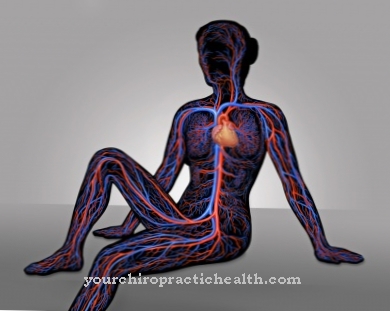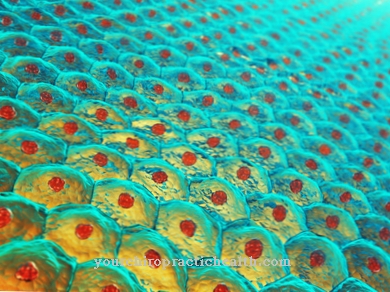The hydrolysis represents the splitting of a chemical compound into smaller molecules with the absorption of water. Hydrolyses play an important role in the inorganic area as well as in biology. In living organisms, hydrolytic cleavage takes place under the influence of enzymes.
What is hydrolysis?

During hydrolysis, chemical compounds are split into smaller molecules when water is absorbed. This applies to both inorganic and biological areas. One part of the molecule connects to the hydroxyl group (OH group) and another part of the molecule connects to the hydrogen ion (H +). In order to obtain neutral molecules, the electron of the hydroxyl group formally migrates to the proton.
These reactions do not usually take place in one step. With simple reactions only a few steps are necessary, while with complicated conversions a catalyst is always involved, which remains unchanged after the completion of all reaction steps.
In biology, hydrolysis is often the breakdown of highly polymeric or composite compounds. The three most important nutrients, carbohydrates (polysaccharides), fats or proteins, are broken down hydrolytically.
In living systems, the reactions always take place in the presence of enzymes. The enzymes are catalysts which are again unchanged after the hydrolytic cleavage and are available for the next reaction.
The reverse of hydrolysis yields water and is known as condensation.
Function & task
Hydrolysis is one of the basic reactions in biological systems. They ensure that large biomolecules are constantly converted into monomers so that they can either be used to build up the body's own substances or to supply the body with energy through their breakdown. Therefore hydrolysis plays a central role in the body.
After eating, the important nutrients carbohydrates, fats and proteins are broken down into their individual components by hydrolysis. In the case of carbohydrates, for example, the polysaccharides are broken down into the monomers glucose when water is absorbed. Fats are glycerine esterified with fatty acids. The hydrolytic cleavage produces the individual fatty acids and glycerine. Proteins are chains of peptidic amino acids that are hydrolytically split into individual amino acids during digestion. Enzymes are involved in all hydrolytic reactions in the body. Enzymes are proteins that catalytically support the reactions. After hydrolysis, the enzymes are unchanged.
Hydrolysis does not only take place in food digestion. As part of the overall metabolism, constant hydrolysis and condensation reactions take place in the body. Enzymes that catalyze hydrolysis are called hydrolases.The hydrolases can in turn be divided into peptidases, esterases or glycosidases. Among other things, peptidases break down proteins with the formation of individual amino acids. Esterases, in turn, can break down fats into fatty acids and glycerine. Then it is lipases. The glycosidases split glycosidic compounds. These are either polysaccharides, in which several sugar molecules are glycosidically linked to one another, or compounds that have a glycosidic bond between a sugar component and a non-sugar component. This is why amylase, which converts starch into glucose, is one of the glycosidases.
Further hydrolases are phosphatases and nucleases. The phosphatases split off phosphate groups hydrolytically. A good example of this reaction is the conversion of ATP (adenosine triphosphate) to ADP (adenosine diphosphate). Overall, hydrolysis always takes place with the release of energy. This is particularly evident in the reaction from ATP to ADP. Because this conversion supplies the energy previously stored in the ATP for other biochemical reactions, heat generation or mechanical movements. Nucleases are responsible for the complete breakdown of nucleic acids. These are again divided into the ribonucleases and deoxyribonucleases. Both enzyme groups hydrolytically split the phosphodiester bonds in the nucleic acid molecule to form the individual nucleotides.
Illnesses & ailments
Since hydrolysis reactions are constantly taking place in the human body, various diseases are also possible in this context. Digestion and many intermediate reactions in the metabolism are hydrolysis reactions. There are special enzymes for each reaction step. However, enzymes are proteins which can also be restricted in their function by genetic changes. The failure or deficiency of every single enzyme can have fatal consequences for health.
Enzymes sometimes have to be present in large quantities, so that an entire organ is necessary for their secretion. This applies, among other things, to the digestive enzymes in the pancreas. The pancreas or pancreas mainly produces lipases and peptidases. It is largely responsible for the digestion of the food that comes out of the stomach. Fats and proteins are broken down into the individual components. The body absorbs the amino acids, fatty acids, glycerine and glucose that are formed through the small intestine. In diseases of the pancreas, massive digestive problems with diarrhea, gas and severe abdominal pain occur. The lack of fat breakdown can lead to fatty stools.
In the acute form of inflammation of the pancreas (pancreatitis), the pancreas can even digest itself with a fatal outcome. The free flow of digestive juices into the small intestine can be disturbed by various causes. They build up in the pancreas and completely dissolve. Even with the chronic forms of pancreatitis, there is constant partial resolution.
Another example of a disease with regard to hydrolytic processes is represented by mitochondrial disease. Due to disturbances in ATP synthesis, the energy-supplying reactions from ATP to ADP can only take place to a limited extent. The mitochondrial diseases express themselves i.a. in chronic fatigue and weakness.



























